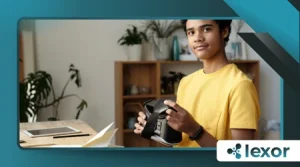How VR Is Enhancing Online Learning for Students

The digital classroom has evolved, and VR is enhancing online learning in ways we once only imagined. Virtual reality is no longer a futuristic concept—it’s reshaping education today.
Students now explore ancient Rome, dissect virtual frogs, and collaborate in immersive 3D spaces, all from their homes. But how exactly is this transformation unfolding?
Unlike traditional e-learning, which often relies on static videos and text, VR creates dynamic, interactive environments.
A biology student doesn’t just read about the human heart—they hold it, rotate it, and watch it pump in real time.
A language learner doesn’t just memorize vocabulary—they practice conversations with AI-powered avatars in a virtual Paris café. The shift from passive to active learning is profound.
The pandemic accelerated remote education, but engagement remained a challenge. Zoom fatigue set in, and completion rates dropped.
Now, VR is enhancing online learning by making education captivating again. Institutions like Stanford and MIT are already integrating VR modules, reporting higher participation and deeper comprehension. The question isn’t whether VR works—it’s how far it can go.
The Immersive Classroom: Beyond Screens and Clicks
Traditional online learning often struggles with engagement. Video lectures and quizzes lack interactivity. VR is enhancing online learning by replacing passive consumption with active participation.
Imagine a medical student practicing surgery in a risk-free environment or a history class walking through the Colosseum as gladiators battle. These experiences aren’t just engaging—they’re unforgettable.
A 2024 study by PWC found that VR learners were 275% more confident in applying skills compared to traditional methods. Retention rates soared by 40%. The numbers speak for themselves.
But immersion isn’t just about flashy graphics. It’s about presence—the brain’s belief that it’s truly “there.” When a student wears a VR headset, their brain processes the experience as real.
This neurological trick boosts memory retention. For example, a student studying marine biology doesn’t just watch a documentary about coral reefs—they dive into one, hearing the ocean currents and seeing fish swim past their fingertips.
The implications for complex subjects are staggering. Engineering students can assemble and disassemble machinery without physical parts.
++What Is an eReader and How Does It Work?
Architecture students walk through their designs before construction begins. VR is enhancing online learning by turning abstract concepts into tangible experiences.
Breaking Geographical Barriers

Geography no longer limits education. A student in rural India can attend a Harvard lecture in a virtual amphitheater.
VR is enhancing online learning by democratizing access. Schools with limited resources now offer lab simulations once reserved for elite institutions. The virtual world erases borders, creating a global classroom.
Platforms like Engage (engagevr.io) host international lectures where students from different continents debate in real time.
A physics class in Nigeria collaborates with peers in Brazil, sharing experiments in a shared virtual lab. This isn’t just convenient—it’s revolutionary.
Language barriers also crumble in VR. Real-time translation tools allow a Japanese student to learn from a Spanish professor without missing a beat.
Cultural exchange happens organically—students visit virtual replicas of global landmarks, guided by native experts. The world becomes the curriculum.
++Virtual Reality in Tourism: Exploring the World from Home
Yet challenges persist. Internet speeds in remote areas can limit access. But initiatives like Facebook’s (now Meta) subsidized VR headsets for schools aim to bridge the gap. The future of education isn’t just digital—it’s borderless.
Hands-On Learning Without the Risks
Chemistry students no longer fear explosions. VR labs simulate reactions safely. Pilots train in virtual cockpits before touching real controls.
VR is enhancing online learning by turning theory into practice. Mistakes become lessons, not disasters.
For example, Medical Realities (medicalrealities.com) uses VR to train surgeons. Trainees repeat complex procedures until mastery—without risking lives.
Read more: Top Real-World Uses of Virtual Reality in 2025
The system provides instant feedback, correcting hand positioning or incision depth. Studies show VR-trained surgeons make 40% fewer errors in real operations.
Vocational training also benefits. Electricians practice wiring virtual circuits before handling live wires. Welders refine techniques in a simulated environment, reducing material waste.
The cost savings are immense—schools no longer need expensive physical equipment for every student.
Even soft skills improve. Business students negotiate with virtual clients, reading body language and adjusting tactics.
Therapists-in-training conduct mock sessions with AI patients. VR is enhancing online learning by providing safe spaces for trial and error.
Social Learning in a Virtual Space
Isolation plagues online education. VR is enhancing online learning by reintroducing human connection.
Avatars collaborate in virtual study groups, debate in 3D forums, and even share virtual whiteboards. Body language and spatial audio make interactions feel real.
Platforms like Spatial (spatial.io) replicate campus life. Students gather in virtual libraries, whispering to avoid disturbing others.
Study groups form naturally, just like in physical classrooms. The social cues—eye contact, gestures—make conversations fluid.
Teachers also gain new tools. Instead of staring at a grid of faces on Zoom, professors move around a virtual lecture hall, making eye contact with individual students.
++What Is VR Training and Why Is It So Effective?
Breakout rooms become 3D spaces where groups huddle around interactive models. The result? Higher participation and fewer distractions.
The psychological impact matters. A 2023 University of Tokyo study found VR learners felt 30% less isolated than traditional online students. When education feels communal, motivation follows.
The Future: Personalized & Adaptive VR Learning
AI-driven VR adapts to each student’s pace. Struggling with algebra? The system adjusts difficulty. Excelling?
It introduces advanced concepts. VR is enhancing online learning by making education as unique as fingerprints.
For instance, language apps like Mondly VR detect pronunciation errors and offer real-time corrections.
A student struggling with verb conjugations gets extra drills, while another breezing through moves to advanced dialogues. The tech personalizes without human intervention.
Neurodiverse students benefit immensely. Those with ADHD focus better in distraction-free VR environments. Autistic learners practice social scenarios at their own pace. The flexibility is unprecedented.
Yet challenges remain. High-quality VR requires robust hardware. But as standalone headsets like Meta Quest Pro become affordable, adoption grows. The next decade will see VR not as a luxury, but a standard.
Ethical Considerations and Accessibility
As VR reshapes education, ethical questions arise. Should all learning be immersive? What about students prone to motion sickness? VR is enhancing online learning, but it’s not a one-size-fits-all solution.
Data privacy is another concern. VR platforms collect vast amounts of biometric data—eye tracking, movement patterns. Schools must ensure compliance with regulations like GDPR. Transparency is key.
Accessibility also matters. Visually impaired students need audio descriptions, while those with mobility issues require adaptive controllers. Companies like Microsoft are pioneering inclusive VR design, but the industry must keep pushing.
The goal isn’t to replace traditional methods, but to augment them. A balanced approach—blending VR with other tools—will yield the best outcomes.
Final Thoughts
The revolution is here. VR is enhancing online learning by merging immersion, accessibility, and interactivity. The classroom of tomorrow isn’t a place—it’s an experience. And it’s only getting started.
From medical training to global collaboration, VR breaks limits we once accepted. The tech isn’t perfect, but its potential is undeniable.
As hardware improves and costs drop, virtual classrooms will become as commonplace as textbooks.
The future of education isn’t on a screen—it’s all around us.
Frequently Asked Questions (FAQs)
1. Is VR really effective for learning?
Yes. Studies show VR improves retention and engagement significantly compared to traditional methods.
2. What subjects benefit most from VR?
Complex, hands-on fields like medicine, engineering, and vocational training see the biggest gains.
3. Are there downsides to VR education?
Motion sickness, cost, and accessibility barriers remain challenges, but tech advancements are addressing these.
4. How expensive is VR for schools?
Prices are dropping. Standalone headsets like Meta Quest 3 start at $500, with bulk discounts for institutions.
5. Can VR replace teachers?
No. VR enhances teaching but can’t replicate human mentorship and adaptability.
6. What’s next for VR in education?
Expect AI integration, haptic feedback suits, and even more realistic simulations in the coming years.
